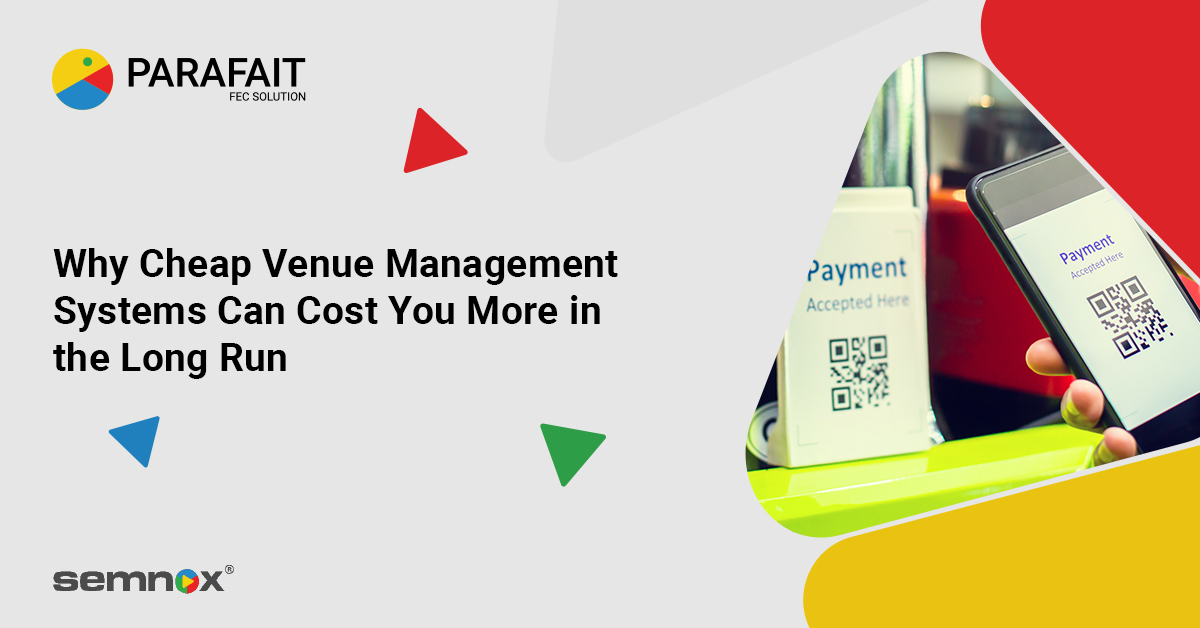
Why Cheap Arcade Management Systems Can Cost You More in the Long Run
Table of Contents
Introduction: Don’t Let Your System Be an Afterthought
Opening a new arcade or family entertainment center is an exciting venture. Most operators begin by focusing on the visible and tangible elements—securing a prime location, sourcing the best arcade machines, finalizing a theme, or creating an Instagram-worthy interior design. Unfortunately, the one thing that often gets pushed to the end of the list is the venue management system.
By the time operators turn their attention to the software needed to run their arcade, it’s often treated as an afterthought. The focus has already been consumed by concept planning, sourcing games for the arcade, branding, and interior design, leaving little time or attention for the system that will power it all. As a result, many underestimate its importance. The budget is already stretched thin. That’s when many look for cheaper alternatives, treating the system as just a billing tool rather than the operational engine of the entire arcade.
But here’s the hard truth: investing in a low-cost, fragmented solution might seem like a budget win upfront, but it often leads to bigger business losses in the long run.
Behind the Bargain: What Cheap Systems Don’t Tell You
For arcade operators, the decision to go with a low-cost management software often feels like a practical one, something simple to process payments and get the doors open. But when it comes to supporting full-scale arcade operations, these systems often fall short and can’t handle the real demands of daily operations. There are three critical areas where low-end systems won’t cut it:
- Quality of Hardware and System Infrastructure
Arcades are fast-paced, high-volume environments that are often physically demanding on equipment. Cheap Systems tend to use low-grade hardware or off-the-shelf devices not designed for continuous, rugged use. Over time, this leads to:
- Hardware breakdowns during operating hours
- Touchscreens and card readers that become unresponsive or glitchy
- Higher maintenance costs and more frequent replacements
Semnox systems, by contrast, use industrial-grade hardware that’s purpose-built for arcade and FEC environments.
- Lack of Operational Control and System Security
Cheaper software solutions often come with limited back-end control. Operators can’t access real-time data, automated processes, or monitor system activities. Worse, these platforms may not meet essential security requirements, exposing your arcade to risks like:
- Data breaches and customer information leaks
- Fraudulent transactions
- Loss of audit trails and accountability
A strong arcade management system does more than process payments, it secures your operations, provides user-level access controls, and helps you maintain trust with every tap and scan.
- System Failures During Peak Hours
There is nothing more damaging to an arcade’s reputation than system crashes during weekends or holidays, just when footfall is at its highest. Cheap systems often fail under pressure, resulting in:
- Clunky user experience for both staff and guests.
- Inability to load game credits or validate gameplay.
- Frequent system failures and no real support.
- Customer complaints, long lines and refunds.
These failures don’t just affect the moment but your online reviews, discourage repeat visits, eat into your profits, and stress your staff out. A reliable system should be built to scale and sustain performance during your busiest hours.
5 Hidden Costs That Sneak Up on You
Let’s break down the silent drains on your arcade’s revenue when you opt for a budget solution:
1. Downtime at Your Busiest = Lost Sales
Most of the time, everything appears to be working just fine. But the real test begins during the chaos of a packed Saturday afternoon or a holiday rush. What seems like minor slowness during normal hours becomes a major disruption when you’re at peak capacity. Every minute your system is down means frustrated customers and missed revenue.
2. Inadequate Support
Cheaper vendors often don’t have dedicated, round-the-clock support. Delays in resolving system issues can cause operational chaos during your busiest hours.
3. Lack of System Flexibility Leads to Operational Inefficiency
Budget systems often lack the flexibility and depth needed to manage the full scope of arcade operations. Without a comprehensive platform, staff are forced to rely on disconnected tools or manual workarounds to handle everything from inventory and game tracking to reporting and customer data. This not only slows down daily operations but also creates inconsistencies that impact both staff efficiency and the guest experience. A flexible, all-in-one solution eliminates these gaps and helps your team work smarter, not harder.
4. Security Risks
Low-cost systems often lack robust data protection protocols. Your venue’s data and your customers’ payment information could be at risk if the system isn’t compliant with modern security standards.
5. The High Cost of Switching Later
When your business grows or your system fails, you’ll eventually need to switch. That transition isn’t just costly—it’s disruptive. And rebuilding your operations around a new system can set you back weeks, if not months.
The True Price of Downtime and Failure
Guests come in expecting a seamless, fun-filled experience. But when systems start slowing down, transactions lag, or staff struggle with workarounds, the excitement quickly turns into frustration. These issues may not happen every day, but they always seem to strike at the busiest times, when your arcade is under pressure. Whether it’s long queues at the counter, delayed credit loads, or staff confusion, the impact is the same: unhappy guests, negative reviews, and lost business. The root cause often lies in systems that weren’t built to scale or handle real-world arcade demands.
Think Long-Term: Your System Is the Heart of Your Arcade
Many operators think of software as just a billing solution. In reality, your venue management system software is the engine that drives every part of your arcade. From guest check-ins and gameplay tracking to inventory, reporting, loyalty programs, and security. When your software lacks flexibility or depth, it slows your operations and limits growth. But when your system is built to scale, it becomes the backbone of a well-oiled arcade, helping you respond faster, serve better, and operate smarter.
Think of it like this: your arcade machines may be the stars of the show, but your system runs the entire production behind the scenes.
What to Look for in a Reliable Venue Management Partner
When choosing your system, don’t just compare prices. Look for a partner who can grow with you. Use this checklist as a guide:
- Unified, scalable platform
- Real-time reporting and integrated CRM
- Proven up time and hardware reliability
- End-to-end security and compliance
- 24/7 customer support
- Client portfolio of successful arcades
- Ability to integrate across FEC attractions
Semnox’s Parafait venue management system checks all these boxes, backed by years of experience, global deployments, and robust service.
Conclusion: Power Your Arcade with the Right System from Day One
Your arcade management system is the backbone of your operations—not just a backend tool. Choosing the right partner from the start sets the foundation for seamless guest experiences, operational efficiency, and long-term growth.
Instead of settling for short-term savings, invest in a solution that’s built to scale with your ambitions.
✅ Smarter operations
✅ Happier guests
✅ Stronger revenues
Let’s build it right.
Connect with the experts at Semnox and discover how the Parafait system can help you unlock your arcade’s full potential—today and into the future.
As a strategic leader with decades of expertise in the out-of-home entertainment and venue management sector, Umesh Prabhu brings a rare blend of technical insight and operational excellence to the table. With his extensive background in global solution delivery and enterprise systems integration, Umesh has been instrumental in shaping how entertainment venues adopt and scale technology.
His leadership at Semnox spans over 15 years, during which he has played a pivotal role in evolving the Parafait suite into a globally trusted solution for amusement parks, FECs, arcades, waterparks, and more. Now at the helm of Parafait’s venue management portfolio, Umesh drives product innovation, seamless customer experiences, and integrated technology ecosystems that redefine operational success for entertainment businesses worldwide

